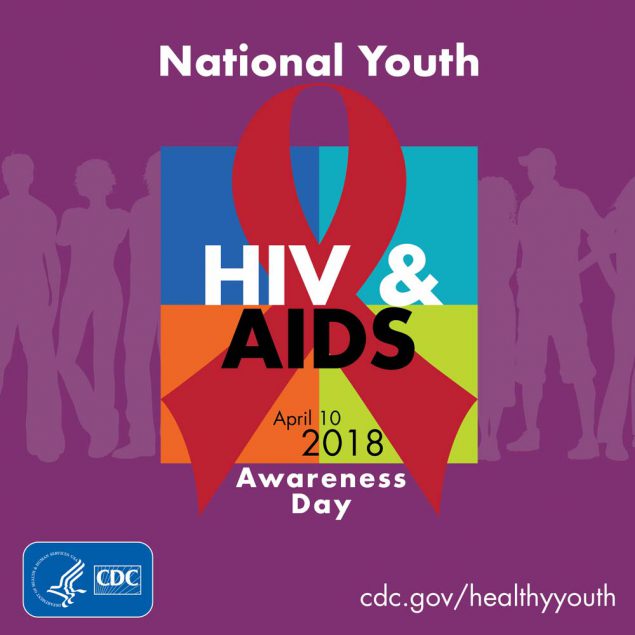National Youth HIV & AIDS Awareness Day

April 10th is National Youth HIV & AIDS Awareness Day (NYHAAD). NYHAAD is the first annual observance day set aside to recognize the impact of the HIV/AIDS epidemic on young people.
National Youth HIV & AIDS Awareness Day (NYHAAD) serves as a reminder that investing in young people’s health and education is a critical step to achieving an AIDS-free generation. This annual observance was created in 2013 by partners to educate the public about the impact of HIV/AIDS on youth.
Youth in the United States
In the United States, 1 in 5 new HIV diagnoses were in young people aged 13-24 years. Despite the disproportionate number of new HIV infections occurring among youth, the percentage tested for HIV is low compared to other age groups. Only 10% of U.S. high school students have ever been tested for HIV.

From 2005 to 2015, CDC data show declines in sexual risk behaviors among youth, including fewer currently sexually active high school students. The proportion of high school students who ever had sex decreased from 47% in 2005 to 41% in 2015.
Still, the prevalence of some behaviors remains high and puts young people at risk. For instance, condom use has decreased among teens, with 43% of sexually active high students not using a condom the last time they had sex. Additionally, some young people, including lesbian, gay, and bisexual (LGB) youth, often remain at greater risk for negative health outcomes. For example, 15% of LGB students have had sex with four or more persons during their life, compared to 12% among all high school students. It is critical to use tailored approaches to reach the highest risk youth with the right interventions, in the right way, at the right time.
Addressing HIV in youth requires that young people are provided the tools they need to reduce their risk, make healthy decisions, and get treatment and care if needed.
The Role of Schools
Schools play a critical role in promoting the health and safety of young people. The nation’s schools provide an opportunity for 56 million students to learn about the dangers of unhealthy behaviors and to practice skills that promote a healthy lifestyle.
Schools and other youth-serving organizations can help young people adopt behaviors that reduce their risk for HIV, sexually transmitted diseases (STDs), pregnancy, and other related health problems. Some ways to encourage youth to stay healthy is to teach them about HIV/AIDS and other STDs, promote communication between youth and their parents, and support student access to confidential HIV counseling and testing services.
What CDC is Doing
CDC engages an established network of leaders in school-based HIV, STD, and pregnancy prevention by funding education agencies that reach nearly 2 million students. These funded partners:
- Deliver HIV, STD, and pregnancy prevention programs grounded in the latest research
- Select and implement effective health education curricula
- Build local capacity to connect students to school- and community-based health services
- Establish safe environments where students feel connected to school and supportive adults
CDC funds national organizations to help education agencies with training, technical assistance, and resource development to increase the impact of local programs.
CDC uses three state-of-the-art monitoring systems designed to collect, analyze, and disseminate data on youth risk behaviors and school health policies and practices. These systems provide state and district level educators with information that they can translate into programs, policies, and practices that reduce health costs and improve students’ lives.
What Can You Do?
CDC recognizes the impact of the HIV/AIDS epidemic on youth and the importance of HIV prevention. On NYHAAD, CDC joins with partners across the country to work to ensure young people know how to protect themselves against HIV. NYHAAD encourages everyone to:
- Get educated. Learn the basic facts about HIV transmission, testing, and prevention.
- Get tested for HIV. CDC recommends that everyone between the ages of 13 and 64 years get tested for HIV at least once as part of routine health care. Contact your health care provider about testing.
To have the most positive impact on adolescent health, parents, schools, and community- and school-based organizations and health centers must work together to help provide safe and nurturing environments for youth.
Help raise awareness about this important day by sharing communication messages and resources.
- NYHAAD Resources Toolkit: This page contains information that is helpful in planning communication activities to inform and educate partners, stakeholders, and media about HIV in youth and the importance of recognizing the impact of the disease on young people. Included are graphics, sample social media posts, and links to additional resources for education agencies, healthcare providers, and parents.
- NYHAAD button: Post this web button on your site.
More Information
Other Resources
- CDC: Healthy Youth Website
- CDC: HIV/AIDS
- Parent Engagement: Strategies for Involving Parents in School Health[1.74 MB]
- School Connectedness: Strategies for Increasing Protective Factors Among Youth[1 MB]
- Health Services for Teens
- Read, download, and share these fact sheets:
- Talking with Your Teens about Sex: Going Beyond “the Talk”[1.47 MB]
- Teen Health Services and One-On-One Time with A Healthcare Provider
- Ways to Influence Your Teen’s Sexual Risk Behavior: What Fathers Can Do[157 KB]
- Parents’ Influence on the Health of Lesbian, Gay, and Bisexual Teens: What Parents and Families Should Know[254 KB]
Campaign Resources
Social Media
- Twitter: @CDC_DASH, @TalkHIV
- Facebook: ActAgainstAIDS
- Instagram: @actagainstaids



































No hay comentarios:
Publicar un comentario